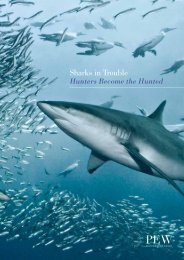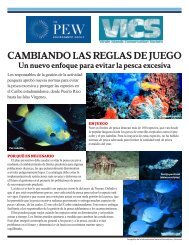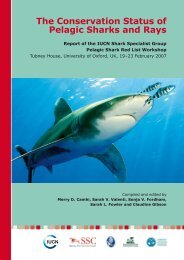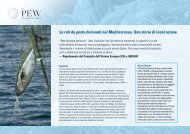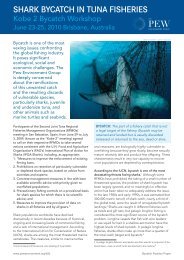Shark Fin ID Guide - Pew Environment Group
Shark Fin ID Guide - Pew Environment Group
Shark Fin ID Guide - Pew Environment Group
You also want an ePaper? Increase the reach of your titles
YUMPU automatically turns print PDFs into web optimized ePapers that Google loves.
Identifying <strong>Shark</strong> <strong>Fin</strong>s:<br />
Oceanic Whitetip, Porbeagle and Hammerheads
Dorsal fin landmarks used in this guide<br />
Apex<br />
Trailing edge<br />
Leading edge<br />
Origin<br />
Free rear tip<br />
<strong>Fin</strong> base<br />
<strong>Shark</strong> fins<br />
The image shows the positions of<br />
the fin types that are highly prized<br />
in trade: the first dorsal, paired<br />
pectoral fins and the lower lobe<br />
of the caudal fin. The lower lobe<br />
is the only part of the caudal fin<br />
that is valuable in trade (the upper<br />
lobe is usually discarded). Second<br />
dorsal fins, paired pelvic fins and<br />
anal fins, though less valuable,<br />
also occur in trade.<br />
Caudal fin<br />
First dorsal fin<br />
Second dorsal fin<br />
Lower caudal lobe<br />
Pectoral fins
The purpose of this guide<br />
Many experts agree that it is necessary to monitor the trade in fins of five shark species of concern:<br />
oceanic whitetip, porbeagle and three species of hammerhead sharks (scalloped, smooth and great).<br />
These species are globally distributed, large-bodied and their fins are traded internationally in large<br />
numbers. Four of the species have at least one population listed as Endangered or Critically Endangered<br />
by the International Union for Conservation of Nature (IUCN). In addition, four of the species are subject<br />
to conservation and management measures in one or more regional fisheries management organizations.<br />
All of these species have also at some point been proposed for inclusion on Appendix II of the<br />
Convention on International Trade in Endangered Species of Wild Fauna and Flora (CITES).<br />
This guide is intended to help enforcement and customs personnel in the provisional identification of<br />
the first dorsal fins of these five shark species. In law enforcement situations, this could provide<br />
probable cause to hold questionable fins, so that expert opinion could be sought or genetic testing<br />
could be conducted to confirm the field identification. The guide focuses on dried, unprocessed first<br />
dorsal fins because these are the most easily identified of the traded fins for these species. More than<br />
500 dorsal fins from over 40 shark species were examined in developing this guide. Although there are<br />
more than 450 species of sharks, most of them (65%) are small-bodied (less than 1 meter in length as<br />
adults) and their dorsal fins are too small to be confused with the dorsal fins from the large-bodied<br />
species covered in this guide. 1 We suggest caution when using this guide to identify fins less than 10<br />
cm across the base. Only the fins of very young oceanic whitetip, porbeagle and the three<br />
hammerhead sharks would be that small. Additional details about the specimens examined are<br />
provided on Page 9 and at www.sharkfinid.org.<br />
<strong>Fin</strong>s from 14 large-bodied shark species make up roughly 40% of the global fin trade. The oceanic<br />
whitetip and three hammerheads in this guide are included in this group and were estimated to<br />
constitute 7-9% of traded fins in 2000. <strong>Shark</strong> fin traders in Asia visually sort fins from these species into<br />
specific trade categories using the shape and color of the fin. 2<br />
This guide describes the key characteristics that can be used to quickly and easily separate the first<br />
dorsal fins of these five species from other types of shark fins in trade (see “At a glance...” below).<br />
Porbeagle and oceanic whitetip first dorsal fins can be rapidly and unambiguously identified to the<br />
species level based on the diagnostic white markings detailed in this guide. The first dorsal fins of<br />
hammerhead sharks as a group can also be rapidly separated from all other large sharks using two simple<br />
measurements that describe their characteristic shape (much taller than they are broad) and color (dull<br />
brown or light grey). The three hammerhead species covered in this guide are the only hammerheads<br />
that are common in international trade. Species identification of hammerhead sharks requires<br />
examination of dorsal and pectoral fin sets (details provided on Page 8) or genetic testing.<br />
At a glance...<br />
The sharks of interest have distinct white dorsal fin markings (1 and 2) OR their dorsal fins are tall, slender<br />
from leading edge to trailing edge and light brown (3).<br />
1 2 3<br />
1
Three steps to using this guide<br />
Step 1. Distinguish 1st dorsal fins from other highly-valued traded fins: pectoral fins and lower<br />
caudal lobes (see below).<br />
Step 2. Look for white 1st dorsal fin markings, and use the flowchart on Page 3 to identify either<br />
porbeagle or oceanic whitetip sharks or exclude many species with black fin markings.<br />
Step 3. Take several simple measurements (Page 4) to help identify hammerhead 1st dorsal fins,<br />
which are much taller than they are broad and are dull brown or light grey.<br />
Step 1: Distinguish 1st dorsal fins from pectoral fins and lower caudal lobes<br />
a. Check the fin color on each side<br />
Dorsal fins are the same color on both sides (see right and left side views below). In contrast, pectoral fins are<br />
darker on the top side (dorsal view) and lighter underneath (ventral view); (see both views below).<br />
Dorsal fin,<br />
right side<br />
Pectoral<br />
fin, top<br />
(dorsal<br />
view)<br />
Dorsal fin,<br />
left side<br />
Pectoral fin,<br />
underneath<br />
(ventral view)<br />
b. Check the base of the fin<br />
Dorsal fins (D) have a continuous row<br />
of closely spaced cartilaginous blocks<br />
running along almost the entire fin<br />
base. When looking at a cross section<br />
of the base of a lower caudal lobe<br />
(LC1), there is typically only a yellow,<br />
“spongy” material called ceratotrichia,<br />
which is the valuable part of the lower<br />
caudal lobe. In some lower caudal<br />
lobes (LC2) there may be a small<br />
number of the cartilaginous blocks, but<br />
they are usually widely spaced and/or<br />
occur only along part of the fin base.<br />
Usually the lower caudal lobe has been<br />
cut along its entire base when removed<br />
from the shark; in contrast, dorsal fins<br />
frequently have a free rear tip that is<br />
fully intact.<br />
LC1<br />
LC2<br />
D<br />
LC1<br />
LC2<br />
D<br />
2
Step 2: Identify porbeagle and oceanic whitetip 1st dorsal fins<br />
START<br />
A STOP in the flowchart below indicates that the fin is<br />
not from a species covered in this guide. Additional<br />
information regarding identification of these shark species<br />
was omitted to keep this guide as concise and easy to<br />
use in the field as possible.<br />
<strong>Fin</strong> is generally<br />
uniform in color<br />
YES<br />
Go to Step 3<br />
on Page 4<br />
NO<br />
Distinct white or<br />
black markings on<br />
fin apex, free rear<br />
tip or trailing edge<br />
Markings are black<br />
Not a<br />
species in<br />
this guide<br />
STOP<br />
Markings are white<br />
Free rear tip is white<br />
Porbeagle<br />
(go to Page 7)<br />
Apex is white<br />
Large, mottled white<br />
patch; fin is very<br />
broadly rounded<br />
Oceanic whitetip<br />
(go to Page 7)<br />
Apex is pointed with<br />
white markings on tip<br />
and along trailing edge<br />
Not a<br />
species in<br />
this guide<br />
STOP<br />
3
Step 3: Identify hammerhead 1st dorsal fins<br />
Take fin measurements<br />
1) Measure fin origin to apex (O-A) with a flexible<br />
tape measure.<br />
2) Measure the fin width (W) at the halfway point<br />
of O-A (i.e., if O-A is 10 cm, measure W at 5 cm<br />
along O-A).<br />
3) Divide O-A by W (O-A/W).<br />
Origin, apex and fin width (measured from leading<br />
edge to trailing edge) are landmarks found to be the<br />
most useful for species identification purposes, as<br />
measurements based on fin height, fin base and free<br />
rear tip were often too variable and dependent on<br />
cut and condition of the fin.<br />
O<br />
1/2 O-A<br />
A<br />
W<br />
<strong>Fin</strong> is “short”<br />
(O-A divided by W<br />
is less than 2.5)<br />
YES<br />
STOP<br />
Not a species<br />
in this guide<br />
NO<br />
<strong>Fin</strong> is “tall”<br />
(O-A divided by W<br />
is greater than 2.5)<br />
<strong>Fin</strong> is dark blue,<br />
black or dark grey<br />
(go to Pages 5-6)<br />
STOP<br />
Not a species<br />
in this guide<br />
<strong>Fin</strong> is brown or<br />
light in color<br />
(go to Pages 5-6)<br />
Hammerhead species<br />
(go to Pages 8-9)<br />
4
Distinguishing hammerhead dorsals from<br />
other tall fins (mako and thresher sharks)<br />
First dorsal fins from mako, thresher and hammerhead sharks are tall and slender from leading to<br />
trailing edge. In the image below, thresher and mako fins (top row) are slate to dark grey in color.<br />
Great hammerhead first dorsal fins (bottom row, left) have a distinctive curved shape and are a<br />
much lighter grey than mako or thresher fins. Scalloped and smooth hammerhead first dorsal fins<br />
(bottom row, right) are similar in shape to the dorsal fins of mako and thresher sharks, but they are<br />
much lighter in color and are usually light brown instead of grey.<br />
Shortfin mako<br />
(Isurus oxyrinchus)<br />
Thresher<br />
(Alopias vulpinus)<br />
Great hammerhead<br />
(Sphyrna mokarran)<br />
Scalloped hammerhead<br />
(Sphyrna lewini)<br />
5
Distinguishing hammerhead dorsals from other tall<br />
fins (guitarfish and blacktip sharks)<br />
Dorsal fins that are tall<br />
and slender and dull<br />
brown or light grey are<br />
probably one of three<br />
species of hammerhead<br />
sharks: great (Sphyrna<br />
mokarran), scalloped<br />
(S. lewini) or smooth<br />
(S. zygaena). <strong>Fin</strong><br />
descriptions for these<br />
three species can be<br />
found on Pages 8 and 9.<br />
A<br />
Guitarfish<br />
Hammerhead<br />
Guitarfish<br />
Tall dorsal fins can also come from<br />
several species of guitarfish or<br />
blacktip sharks. In guitarfish first<br />
dorsal fins, cartilaginous blocks do<br />
not extend across the entire fin base<br />
(Image A). In hammerheads, these<br />
cartilaginous blocks are present along<br />
almost the entire fin base (Image A).<br />
Guitarfish dorsal fins also exhibit a<br />
glossy sheen (Image B), and some<br />
species also have white spots, unlike<br />
the dull brown, uniform coloration of<br />
hammerhead dorsal fins.<br />
B<br />
Guitarfish<br />
first dorsal<br />
Guitarfish<br />
second dorsal<br />
Scalloped hammerhead<br />
first dorsal<br />
Some blacktip shark (Carcharhinus<br />
limbatus) first dorsal fins exhibit<br />
O-A/W that is close to or slightly<br />
greater than 2.5. However, they often<br />
(but not always) have a black spot on<br />
the dorsal fin apex, and the fin has a<br />
glossy appearance that is unlike the<br />
dull of the hammerheads (Image C).<br />
C<br />
Blacktip<br />
Scalloped<br />
hammerhead<br />
Blacktip shark pectoral fins are also<br />
longer and more slender than the<br />
short, broad fins of the hammerheads<br />
(Image D).<br />
D<br />
Blacktip<br />
Scalloped<br />
hammerhead<br />
6
Porbeagle Lamna nasus<br />
IUCN Red List<br />
Designation<br />
VULNERABLE<br />
1st dorsal fin: dark<br />
blue/black to dark<br />
greyish brown,<br />
rounded apex with<br />
white patch on lower<br />
trailing edge onto free<br />
rear tip<br />
Courtesy of NOAA Fisheries Service<br />
Pectoral fins: short, rounded at apex; ventral<br />
surface has dusky coloration from apex throughout<br />
midsection of fin and along leading edge<br />
Dorsal view<br />
(top)<br />
Ventral view<br />
(underneath)<br />
©IUCN<br />
IUCN Red List Designations: NE Atlantic and the Mediterranean<br />
subpopulations are Critically Endangered, and the NW Atlantic subpopulation<br />
is designated as Endangered<br />
Oceanic Whitetip Carcharhinus longimanus<br />
IUCN Red List<br />
Designation<br />
VULNERABLE<br />
1st dorsal fin: large<br />
and broadly rounded<br />
(paddle-like); mottled<br />
white color at apex<br />
Pectoral fins: long, broadly rounded at apex;<br />
dorsal surface has mottled white color at apex;<br />
ventral surface is typically white but can have<br />
mottled brown coloration<br />
➤ mottled white color also present on caudal fin<br />
(upper and lower lobe)<br />
➤ very small juveniles may have mottled black<br />
coloration on dorsal, pectoral and caudal fins<br />
Courtesy of NOAA Fisheries Service<br />
©IUCN<br />
Dorsal view<br />
(top)<br />
Ventral view<br />
(underneath)<br />
IUCN Red List Designations: NW Atlantic and Central Atlantic<br />
subpopulations are designated as Critically Endangered<br />
7
Scalloped Hammerhead Sphyrna lewini<br />
IUCN Red List<br />
Designation<br />
ENDANGERED<br />
1st dorsal fin: tall, flattening<br />
out toward apex; straight to<br />
moderately curved trailing<br />
edge (similar to smooth<br />
hammerhead, less slender<br />
than great hammerhead 1st<br />
dorsal fin)<br />
Courtesy of NOAA Fisheries Service<br />
Pectoral fins: short and broad with black tips<br />
visible at the apex on ventral side<br />
Dorsal view<br />
(top)<br />
Ventral view<br />
(underneath)<br />
©IUCN<br />
Smooth Hammerhead Sphyrna zygaena<br />
IUCN Red List<br />
Designation<br />
VULNERABLE<br />
1st dorsal fin: tall, sloping more<br />
at apex; moderately curved<br />
trailing edge (similar to scalloped<br />
hammerhead, less slender than<br />
great hammerhead 1st dorsal fin)<br />
Note: Scalloped and smooth<br />
hammerhead 1st dorsal fins are so<br />
similar they are often extremely hard<br />
to differentiate. However, it is not<br />
uncommon for valuable fins from an individual to be traded as<br />
a set (first dorsal, paired pectoral fins and lower caudal lobe).<br />
If this is the case, the two species can be distinguished using<br />
the pectoral fins.<br />
Courtesy of NOAA Fisheries Service<br />
Pectoral fins: short and broad with faint to no<br />
markings on ventral side<br />
Dorsal view<br />
(top)<br />
Ventral view<br />
(underneath)<br />
©IUCN<br />
8
Great Hammerhead Sphyrna mokarran<br />
IUCN Red List<br />
Designation<br />
ENDANGERED<br />
1st dorsal fin: tall, slender<br />
from leading edge to trailing<br />
edge; elongated and pointed<br />
at apex<br />
Note: Small to moderate-sized<br />
great hammerhead first dorsal<br />
fins may be difficult to distinguish<br />
from those of the winghead<br />
shark (Eusphyra blochii). However,<br />
wingheads are only found in India, Thailand, Indonesia and<br />
Northern Australia and are extremely rare in trade. On a<br />
global basis, 1st dorsal fins with this shape are much more<br />
likely to be from great hammerheads than wingheads.<br />
Courtesy of NOAA Fisheries Service<br />
Pectoral fins: Pointed apex, moderately curved<br />
along trailing edge with dusky color at apex on<br />
ventral side and often along trailing edge<br />
Dorsal view<br />
(top)<br />
Ventral view<br />
(underneath)<br />
©IUCN<br />
About the guide<br />
This guide is based on data collected during the examination of more than 500 dorsal fins and 900 pectoral fins from<br />
over 40 shark species, including all of the dominant species or species groups in the international fin trade reported<br />
in Clarke et al. (2006). 3 Conspicuous fin markings were also assessed for pattern and consistency within species using<br />
photographs published in the literature and on the internet. <strong>Fin</strong> sets originated from the United States, Belize, Chile,<br />
South Africa, Fiji and New Zealand and included a wide size range for each species. <strong>Fin</strong>s and fin sets examined in this<br />
study were provided by fishermen, fin traders and scientists: no sharks were sacrificed for this project. Photos of whole<br />
shark specimens are courtesy of the NOAA’s Pelagic Observer Program (POP). Porbeagle fin photos on Page 7 were<br />
provided by Sebastian Hernandez. Dorsal fins on Page 3 were provided by Angelo Villagomez (whitetip reef) and Guy<br />
Stevens (silvertip). Cover photos were provided by David Fleetham/OceanwideImages.com (oceanic whitetip), Doug<br />
Perrine/SeaPics.com (porbeagle) and Chris & Monique Fallows/OceanwideImages.com (scalloped hammerhead cover<br />
and inside cover). All other fin photos were provided by Debra Abercrombie. We would like to thank the Kwa-Zulu<br />
Natal <strong>Shark</strong>s Board, the New Zealand Department of Conservation, the Fiji Department of Fisheries, the U.S. National<br />
Marine Fisheries Service, the Florida Fish and Wildlife Conservation Commission, and the Belize Department of<br />
Fisheries for assistance.<br />
This work was supported by the <strong>Pew</strong> <strong>Environment</strong> <strong>Group</strong> and the Roe Foundation and compiled by Debra L.<br />
Abercrombie, Abercrombie & Fish, and Demian D. Chapman, Ph.D., School of Marine and Atmospheric Sciences and<br />
Institute for Ocean Conservation Science, Stony Brook University, Stony Brook, NY (USA).<br />
1. Musick, J.A., et al. “Historical Zoogeography of the Selachii,” in Biology of <strong>Shark</strong>s and Their Relatives, ed. Jack A. Musick et al., CRC Press, 33-78 (2004).<br />
2. Clarke, S.C., et al., “Identification of shark species composition and proportion in the Hong Kong shark fin market based on molecular genetics and trade<br />
records,” Conservation Biology, 20:201-211 (2006).<br />
3. Ibid.<br />
9
For more information:<br />
Jill Hepp<br />
Manager, Global <strong>Shark</strong> Conservation<br />
<strong>Pew</strong> <strong>Environment</strong> <strong>Group</strong><br />
901 E St. NW<br />
Washington, DC 20004, USA<br />
Tel: +1-202-552-2000<br />
Email: info@pewtrusts.org<br />
www.pewenvironment.org/sharks<br />
Demian D.F. Chapman, Ph.D.<br />
Assistant Professor<br />
School of Marine and Atmospheric Sciences<br />
Stony Brook University<br />
Stony Brook, NY 11794, USA<br />
Tel: +1-631-632-8731<br />
Email: Demian.Chapman@stonybrook.edu<br />
www.sharkfinid.org




